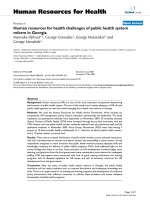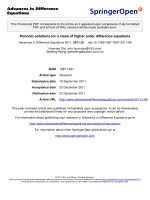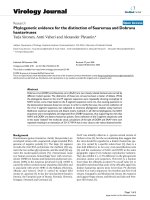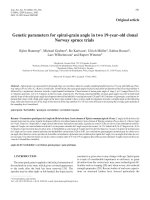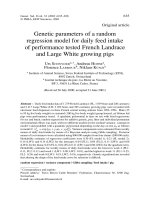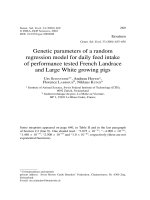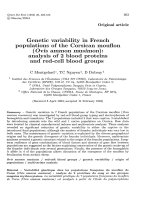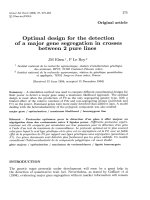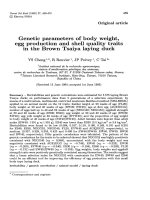Báo cáo sinh học: "Genetic parameters for lactation traits of milking ewes: protein content and composition, fat, somatic cells and individual laboratory cheese yield" ppt
Bạn đang xem bản rút gọn của tài liệu. Xem và tải ngay bản đầy đủ của tài liệu tại đây (106.93 KB, 16 trang )
Genet. Sel. Evol. 34 (2002) 581–596
581
© INRA, EDP Sciences, 2002
DOI: 10.1051/gse:2002024
Original article
Genetic parameters for lactation traits
of milking ewes: protein content
and composition, fat, somatic cells
and individual laboratory cheese yield
Med. Houcine O
THMANE
, Juan Antonio C
ARRIEDO
,
Fermin S
AN
P
RIMITIVO
, Luis Fernando D
ELA
F
UENTE
∗
Departamento de Producción Animal I, Universidad de León, 24071 León, Spain
(Received 12 July 2001; accepted 25 February 2002)
Abstract – The effects of some environmental variation factors and the genetic parameters for
total milk traits (fat content, protei n content, casein content, serum protein content, lactation
mean of individual laboratory cheese yield (LILCY), lactation mean of somatic cell count
(LSCC), and milk yield) were estimated from the records of 1 111 Churra ewes. Genetic
parameters were estimated by multivariate REML. Heritability for fat content was low (0.10) as
is usually found in the Churra breed. Heritabilities for protein content, casein content, serum
protein content, LILCY, milk yield and somatic cell count were 0.31, 0.30, 0.22, 0.09, 0.26
and 0.11, respectively. The highest heritability estimates were for protein and casein contents.
Casein content is not advisable as an alternative to protein content as a selection criterion for
cheese yield improvement; it does not have any compelling advantages and its measurement
is costly. Our results for LSCC indicated that efforts should focus on improving the level of
management rather than selecting for somatic cells, in the actual conditions of the Churra breed.
dairy ewes / casein content / individual laboratory cheese yield / genetic parameters /
selection goal
Abbreviation key: LILCY = lactation mean ofindividuallaboratory cheese
yield; LSCC = lactation mean somatic cell count (in their natural logarithmic
form); FYS = flock-year-season; L30-120 = milk yield obtained between 30
and 120 days.
1. INTRODUCTION
Interest in research into the yield and composition of milk from small
ruminants in general has increased in recent decades because of the growing
∗
Correspondence and reprints
E-mail:
582 M.H. Othmane et al.
intensification of sheep and goat production systems [24,29] and the initiation
of breeding programmes [22]. The protein content and composition of sheep
milk are important to the cheese manufacturer and are considered a major factor
in determining the yield and quality of the final product.
Selecting for casein content would constitute a change in breeding goals
from the current practice of selecting firstly for milk yield and secondly for
fat content and/or protein content. Although there are numerous estimates
for milk yield and fat traits, corresponding information on protein traits is
restricted to crude or true protein. No heritability estimates were found for
casein and serum protein contents nor their genetic relationships with other
milk traits. The estimation of genetic parameters for casein content would help
in re-examining the selection programmes in the future.
The individual laboratory cheese yield (ILCY) is one variable that can be
determined for each milk sample of milk recording [38]. Thus, it is of great
interest to estimate the genetic parameters of the lactation mean of individual
laboratory cheese yield for this trait (LILCY) and its genetic and phenotypic
relationships with milk traits. This estimator could improve selection decisions
for sheep breeds, since cheese yield relies mainly on the milk components.
The somatic cell count is a good indicator of the existence of subclinical
mastitis [25], and some studies on dairy cows associated the variation of protein
content and composition to a change in somatic cell count [3,5,49]. Never-
theless, little information is available on the genetic parameters of lactation
measures for somatic cell count (LSCC) or the relationships between LSCC
and yield or the composition of the milk of dairy ewes [7,17].
The objective of our study was t o estimate the genetic parameters for
lactation measures of fat, protein, casein and serum protein contents, LILCY
and LSCC. Environmental factors, heritabilities, repeatabilities, and genetic
and phenotypic correlations among these variables were estimated using a
multitrait repeatability animal model.
2. MATERIALS AND METHODS
2.1. Data
Data were collected on dairy farms from three regions in Castile and León,
Spain. A total of 1 962 lactation records were obtained, between April 1997
and July 1999, from 1 111 Churra ewes belonging to eight flocks at the Churra
selection nucleus. All flocks were on the alternate a.m p.m. plan of testing
and all ewes were milked twice daily.
According to the testing programme applied for Spanish dairy ewes, milk
yield is defined by the production during the milking period only, beginning
after one month of suckling. Accordingly, only the decreasing part of the lacta-
tion curve is recorded while the milk solid contents are increasing throughout
Genetic parameters for lactation traits in ewes 583
that period. The first test day record was obtained at least 3 d after weaning
(between the 31st and 75th d postpartum). Subsequent records were obtained
at approximately monthly intervals thereafter.
Previous studies on indigenous Spanish breeds have shown very low herit-
ability estimates for fat content [8,34]. Data originating in the milk recording
schemes always give much lower heritability and repeatability estimates than
those reported for other components such as protein content [14,34]. The
three factors most likely to cause such results are management conditions
(dependent on the stockbreeder’s knowledge), data collection or a possible
inadequate analysis of milk samples. In this study, we collected, transported
and analyzed milk samples in the dairy plant of León University in order
to avoid the effects of collection, transport and analysis of samples on the
genetic estimates for fat content i n Churra ewes. Analyses for fat and protein
contents and composition were determined by a AEGYS MI 200 spectrometer
(ANADIS
®
, Trappes, France) based on the mid infrared FTIR method (Fourrier
Tranformed InfraRed) and were calibrated against known sample standards.
Test day ILCY (individual laboratory cheese yield), expressed in kg per 100 L
of milk, was measured from individual milk samples (10 mL), compatible
with milk recording in dairy sheep. ILCY was measured as described by
Othmane [38]: preheated and homogenised milks were curdled at 37
◦
Cfor
1 h. In order to facilitate rennet distribution in the milk, the rennet was diluted
10-fold with bidistilled water before addition to the milks. ILCY was thus
measured, the coagulum (cottage cheese + whey) being centrifuged for a
standard time of 15 min at 2 500 rpm after longitudinal cutting and the whey
being removed after draining for 45 min with the test-tube face downward (the
curd remained quiescent at the bottom of the tube). ILCY was defined as the
weight of the centrifuge residue (curd obtained after expulsion of whey and
draining in the open air) expressed in kg per 100 L of milk.
Milk yield per lactation, estimated and adjusted to 90 d (L30-120)using
the Fleischmann method, was provided by the National Association of Spanish
Churra Breeders (ANCHE) as well as the test day records for somatic cell
count. The SCC were determined using the Fossomatic method as described by
Gonzalo et al. [23]. Test day records of somatic cell count were transformed to
their logarithmic form [2]. From the ANCHE data file other available pertinent
information included t he date of milk sampling, number of suckled lambs, date
of birth of the ewe and lambing date.
Lactation measures of milk composition traits (fat content, protein content,
casein content, serum protein content, LSCC and LILCY) were obtained as
the means of the corresponding monthly test day records preadjusted for stage
of lactation and morning-evening test date using additive factors [17]. These
correction factors were obtained by employing a fixed model that included
the fixed effects: test date record (a.m. or p.m.), flock test date nested to test
584 M.H. Othmane et al.
day record (130 levels), stage of lactation (6 levels), age of ewe (4 levels) and
lambing type (one lamb or more).
The mean number of test day records per lactation was 3.76 (696, 1 045, 216
and 5 lactations with 3, 4, 5 and 6 records, respectively) and mean lactation
records per ewe were 1.77. The animals included in the relationship matrix
(two generations) were 2 021 ewes and 184 rams. The rams included 59 non-AI
rams, 85 AI rams with ≥ 10 daughters in the data file and 40 rams with less
than 10 daughters. Some ewes (123) having their own data were also listed as
the dams of ewes. All pedigree data were verified using DNA genetic markers
as described by Bragança et al. [10].
2.2. Statistical analysis
Data were gathered according to the different levels of the main environ-
mental variables that were thought to affect milk yield and composition in the
Churra breed conditions [11]. There were four lambing age groups (1: between
1and2yrs;2:between2and3yrs;3: between3and4yrs;and4:over4yrs),
two types of lambing (single or multiple), and 41 levels of flock-year-season
(FYS) of lambing. Each year was divided into three seasons: January to March,
April to June, and July to December.
All known relationships among individuals were considered in the model of
analysis that included the previous fixed effects. The dependent variables were
fat, protein, casein and serum protein contents, LSCC, L30-120 and LILCY.
Data of these lactation measures were analysed with the following multitrait
repeatability animal model:
Y
ijklm
= µ + FYS
i
+ LG
j
+ LT
k
+ A
l
+ PE
l
+ e
ijklm
where
Y
ijklm
= dependent variable;
µ = population mean;
FYS
i
= fixed effect of flock-year-season i;
LG
j
= fixed effect of lambing age j;
LT
k
= fixed effect of lambing type k;
A
l
= additive genetic random effect of the individual l;
PE
l
= permanent environmental random effect on the individual l;
e
ijklm
= random residual.
Genetic parameters were estimated by the REML (restricted maximum
likelihood estimation) [36] using the VCE package [28]. The environmental
effects were estimated by the GLM and VARCOMP procedures using the
Statistic Analysis System programme, SAS
®
package [43]. The fixed effects
were treated as random in the VARCOMP procedure. The proportion of
Genetic parameters for lactation traits in ewes 585
Table I. Arithmetic means (¯x), standard deviations (SD) and residual standard devi-
ations (RSD) of the lactation traits.
Trait ¯xSD
1
RSD
2
Milk yield (L30-120) (L) 93 30.9 23.9
Fat content (g · L
−1
) 74.9 10.5 9.3
Protein content (g · L
−1
) 61.1 4.7 3.6
Casein content (g · L
−1
) 48.4 4.1 3.2
Serum protein content (g · L
−1
) 12.1 0.8 0.7
LILCY
3
(kg · 100 L
−1
) 27.2 3.2 2.9
LSCC
4
12.1 1.3 1.0
1
Derived from the sum of the additive genetic, permanent environmental, and
residual variances obtained from the VCE analysis.
2
From VCE.
3
LILCY = lactation mean of individual laboratory cheese yield.
4
LSCC = lactation mean of somatic cells (in their natural logarithmic form).
variance explained by the FYS factor was calculated by dividing the variance
component of the FYS factor by the sum of the residual and FYS variance.
3. RESULTS
The means for milk yield, fat content, protein content, casein content and
serum protein content (Tab. I) were within the range of estimates that have been
recorded for dairy sheep in the Mediterranean countries [20,33,40]. The LSCC
obtained from the current study coincided with the previous results reported
for Churra ewes and were higher than those reported for Lacaune ewes [7]
and f or dairy cows [13,18]. No s tudies have been carried out on the individual
cheese yield on a laboratory scale from the milk amounts compatible with those
usually collected according to the milk recording scheme (50 mL). The LILCY
value obtained from this study coincided with those reported for real cheese
yield in dairy ewes [4,41]. However, the yield of laboratory-scale cheese, like
cottage cheese, tended to be higher than that of ripened cheese [32] as expected.
This was probably attributable to the very reduced milk amounts employed and
the forced draining (centrifugation) of the cottage cheese, which captures even
the smallest curd that may be lost with the whey in the industrial process.
3.1. Environmental variation factors
Flock-year-season (FYS) and age of the ewe at lambing contributed sig-
nificantly (P < 0.001) to the variations in milk yield, fat, protein, casein,
586 M.H. Othmane et al.
Table II. Least square means of total milk traits by age of ewe and lambing type.
Variable Ewe’s age Lambing type
1–2 yr 2–3 yr 3–4 yr > 4yr 1 > 1
Milk yield (L30-120) (L) 93
c
93
c
101
b
106
a
94
b
102
a
Fat content (g · L
−1
) 67.4
c
67.8
c
70.2
b
72.4
a
70.4
a
68.5
b
Protein content (g · L
−1
) 58.1
b
59.6
a
60.5
a
60.3
a
59.6 59.6
Casein content (g · L
−1
) 46.0
b
47.2
a
48.0
a
47.8
a
47.2 47.2
Serum Protein content (g · L
−1
) 11.6
b
12.0
a
12.1
a
12.0
a
11.9 12.0
LILCY
1
(kg · 100 L
−1
) 26.7
b
26.6
b
27.1
a
27.3
a
27.0 26.9
LSCC
2
11.9 12.3 12.1 12.2 12.1 12.2
a,b,c
Means in a row (within variation factor) with different superscripts differ
(P < 0.05).
1
LILCY = lactation mean of individual laboratory cheese yield.
2
LSCC = lactation mean of somatic cells (in their natural logarithmic form).
serum protein and LILCY. The LSCC was significantly affected (P < 0.001)
by FYS but was not affected by lambing age. The lambing type effect was
significant (P < 0.01) for milk yield and fat content and not significant for
protein fractions, LILCY and LSCC.
The FYS factor became the major variation factor for all variables. It
accounted for 27%, 26%, 27%, 28%, 38%, 19% and 100f the phenotypic
variance in fat content, protein content, casein content, serum protein content,
LILCY, milk yield and LSCC, respectively. Similar results for milk yield,
protein content and LSCC were reported for the same breed [17]. No results
had been reported for the rest of the variables. These results demonstrated the
importance of the FYS environmental effect for genetic models with lactation
variables.
Table II shows the effect of lambing age and lambing type on the variables
studied. All variables except LSCC were affected by the age of the ewe at
lambing. The youngest ewes produced the least amount of milk which was
also the least rich in fat, protein, casein and serum protein contents. As the
ewes became older, there was an increase in fat and protein contents and the
milk yield was higher. Accordingly, the highest LILCY were obtained from
the oldest ewes, and vice versa. LSCC was not altered by the age of the ewe.
Although such a result may be unexpected, Sevi et al. [45] have also recently
reported that somatic cell counts in Comisana ewes’ milk and the prevalence
of subclinical mastitis were not changed by parity. In our study, this fact can
be explained by the major mastitis control routinely applied to the flocks used:
teat dip after milking, selective dry therapy, and culling of ewes with chronic
mastitis.
Genetic parameters for lactation traits in ewes 587
Table III. Heritabilities (h
2
), proportions of permanent environmental variance (c
2
),
their standard error (SE), and repeatabilities (r) for total milk traits.
Trait h
2
SE c
2
SE r
Milk yield (L30-120) (L) 0.26 0.03 0.14 0.03 0.40
Fat content (g · L
−1
) 0.10 0.03 0.11 0.03 0.21
Protein content (g · L
−1
) 0.31 0.03 0.07 0.03 0.38
Casein content (g · L
−1
) 0.30 0.03 0.07 0.03 0.37
Serum protein content (g · L
−1
) 0.22 0.02 0.04 0.02 0.26
LILCY
1
(kg · 100 L
−1
) 0.09 0.02 0.07 0.02 0.16
LSCC
2
0.11 0.03 0.23 0.04 0.34
1
LILCY = lactation mean of individual laboratory cheese yield.
2
LSCC = lactation mean of somatic cells (in their natural logarithmic form).
Lambing type had a significant effect on milk yieldand fat content and a non-
significant effect on proteinfractions, LSCC and LILCY. This result agrees with
others on Churra [12,17,20] and Latxa [21] ewes for fat and protein contents
and somatic cells. Ewes that gave birth to multiple lambs had a higher milk
yield (102 L) than ewes that gave birth to singletons (94 L). The physiological
explanation of this fact is that a high number of lambs corresponds to a greater
placenta area which results in higher mammary hormone level and a more
developed udder [16].
3.2. Heritability and repeatability coefficients
Table III presents the heritabilities, permanent environmental variance pro-
portions, and repeatabilities for lactation traits studied. Heritability and repeat-
ability estimated for milk yield from this study (0.26 and 0.38) coincided with
the other results previously reported for the same breed [12,17] and other dairy
ewes [42,44]. Estimates for fat content remained low in spite of precautions
taken in sampling and milk analysis at our dairy plant. Heritability and
repeatability of fat content were especially low (0.10 and 0.21, respectively), as
were those obtained by Jurado et al. [34] in the Spanish Manchega breed. We
think that our results were probably influenced by the enormous variability in
conditions of milking practice and management in general for the Churra breed
(hand stripping, nutrition, etc.), the possible effects of sample collection and
analysis being discarded. Heritability estimated for protein content (0.31) was
higher than our previous result (0.17) in the same breed [17] and lower than
the results reported for other breeds [7,15,42]. Greater values were reported
for the Lacaune breed, with the methods of management being more uniform,
the production level higher and only the first lactation records being normally
588 M.H. Othmane et al.
used. The heritability of adjusted LSCC obtained from this study was 0.11.
This value was below the heritability estimates reported for dairy cattle [13,35,
50], which is likely to be due to the smaller number of test-days per lactation
in dairy ewes. However, we know of only two previous studies on the genetic
parameters for lactation mean of SCC in dairy ewes. These estimates were
obtained from flocks in the Churra and Lacaune breeds. The first one, involving
both heritability and r epeatability [17], gave estimates similar to ours. The
second study, including only heritability in first lactation [7], reported higher
estimates (0.15 to 0.18).
There were no previous genetic studies for protein fractions or individual
cheese yield in dairy ewes. The casein content in milk was assumed to be a
major factor determining cheese yield and quality [31,37] but there was no
available information on its inheritance and genetic relationships, with protein
content and cheese yield allowing it to be judged as a selection criterion.
In our study, the highest heritabilities corresponded to protein content and
composition (Tab. III). Heritabilities and repeatabilities for protein and casein
contents were similar and relatively high. Furthermore, both traits had a
comparable genetic variation coefficient (4.3% and 4.6%, respectively). A
lower heritability (0.22) and repeatability (0.26) were found for serum protein
content, since the changes in protein composition by the various environmental
factors are more manifest in the case of serum protein content than in that of
casein or protein content [26,30].
Estimates of heritability and repeatability for LILCY obtained under Churra
breed conditions seemed particularly low (0.09 and 0.16, respectively) in com-
parison with the other milk components. Such results were probably influenced
by those of fat content. The cheesemaking ability undoubtedly depends on the
main milkcomponents, thoughit couldalso possiblybe considered asa function
of several other factors difficult to identify at times, such as rennet strength,
atmospheric conditions, etc. Our interpretation may explain i n part the high
phenotypic and environmental variability (not shown) observed for this trait as
well as for fat content.
3.3. Genetic and phenotypic correlations
Genetic and phenotypic correlations among lactation traits are given in
Table IV. Correlations between milk yield and qualitative traits were clearly
negative, suggesting that selection by milk yield is expected to be associated
with a r eduction in fat content, protein content, casein content and LILCY.
Thus, these negative associations might imply the necessity of including con-
tent traits in selection programmes if their levels are to be maintained while
increasing milk yield. For milk composition, both genetic and phenotypic
correlations were high and positive, usually with the genetic correlation being
higher than the phenotypic correlation. This pattern is often found [6,7,17]
Genetic parameters for lactation traits in ewes 589
Table IV. Genetic
†
(lower triangle) and phenotypic (upper triangle) correlations among total milk traits.
Trait L30-120 TF TP TC SP LILCY LSCC
Milk yield (L30-120) (L) −0.09 −0.04 −0.01 −0.12 −0.11 −0.16
Total fat content (TF) (g · L
−1
) −0.56 0.48 0.50 0.22 0.41 0.03
Total protein content (TP) (g · L
−1
) −0.64 0.85 0.99 0.66 0.29 0.14
Total casein content (TC) (g · L
−1
) −0.65 0.85 0.99 0.55 0.29 0.12
Serum Protein content (SP) (g · L
−1
) −0.59 0.81 0.96 0.96 0.09 0.14
LILCY
1
(kg · 100 L
−1
) −0.59 0.80 0.85 0.86 0.73 0.05
LSCC
2
−0.17 −0.08 0.15 0.12 0.31 0.30
1
LILCY = lactation mean of individual laboratory cheese yield.
2
LSCC = lactation mean of somatic cells (in their natural logarithmic form).
†
Standard errors of genetic correlations ranged from 0.06 to 0.13.
590 M.H. Othmane et al.
with the usual traits (milk, fat and protein). Our estimates of the phenotypic
correlations were in the range of 0.22 to 0.99, whereas the genetic counterparts
were in the range of 0.81 to 0.99. Estimates of the phenotypic correlations
confirmed the results of some previous studies [20,39]. However, our estim-
ates were slightly more positive between casein and serum protein contents.
For the genetic correlations, there were no previous results on this topic for
comparison. A high correlation coefficient was close to unity (0.99) found
between casein and protein contents. We must bear in mind that protein and
casein contents had the highest and very close heritabilities and presented
similar correlations with the rest of the variables (Tab. IV). The correlated
responses in the main milk components and in LILCY are expected to be
similar when selection is by casein or protein content, with the latter being
readily available from standard milk recording. In principle, such results
detract interest from casein content as a selection criterion for higher cheese
yield.
Fat content had high, positive correlations with protein content and compos-
ition and LILCY, the highest being with protein and casein contents. The high
level of association between fat and protein contents (0.85) is of great interest
for the Spanish breed selection programmes where genetic estimates for fat
content have been much lower than those reported for other dairy sheep breeds
as mentioned above.
The genetic correlation between milk yield (L30-120) and somatic cells
(LSCC) was negative (−0.17) and consistent with that reported for the same
breed [17]. However, Barillet et al. [7] reported a low, positive association
(0.07 and 0.09 for the sire model and animal model, respectively) for Lacaune
ewes. These correlations depend, in part, on the degree of infection within
the population that we are dealing with. In fact, in spite of the strict mastitis
control measures and the general high level of husbandry a pplied to the flocks
used in this study, the arithmetic average SCC (749 000 cell · mL
−1
) duplicated
that reported by the same authors in the Lacaune breed (375 000 cell · mL
−1
),
with only 10% infected ewes in first lactation.
It is commonly assumed that milk from a teat affected by mastitis is richer
in nitrogenous matter [3,20,27,41,49]. An increase in the protein fractions
was in fact accompanied by an increase in LSCC. A higher correlation was
observed with serum protein content (0.31) than with whole protein (0.15) or
casein content (0.12), as is usually found in the literature. This association is
generally explained by a greater permeability of the udder epithelial membrane
to blood protein in t he case of infection. The positive correlation between
LSCC and casein content was probably due to a temporal increase in the casein
ratio in the case of acute mastitis because of the massive destruction of acinar
cells which liberate casein in larger quantities [27]. Such a result could also be
explained by the decrease in milk production in the case of mastitis.
Genetic parameters for lactation traits in ewes 591
As expected, LILCY showed negative correlations with milk yield and
positive and high correlations with protein fractions and fat. However, its
relationships with LSCC did not show a specific pattern from a phenotypic and
genetic point of view. The phenotypic estimate was positive but very close to
zero (0.05), suggesting that LILCY and LSCC were essentially independent.
However, the genetic correlation between both traits was positive and relatively
high, a result that would follow from the positive correlation between LSCC
and protein content and composition.
4. DISCUSSION
On the whole, our estimates fall within the range of the results already
published on Spanishdairy ewes for theusual total milk traits,with theestimates
for fat content being very low. Our results, however, tend to be l ower than
others for certain foreign breeds raised under different management conditions.
There are, of course, many possible reasons for this trend. Among them is
the enormous dive rsity in management practices that characterise the entire
population, low production level, and the relatively recent (barely 15 years)
selection programme and their associated consequences. Implementation of an
efficient breeding programme over a long period of time, better fulfilment of
nutritional needs and diet formulation, and careful attention to mastitis control
and milking management for sheep breeds, such as the Sarde and Lacaune,
should not be forgotten, although in the latter case only first lactation records
were usually used. In this way, available information on dairy cows indicates
that heritability estimates increase with a higher production level [48] and
decrease with more lactations [9].
As for fat content, we consider that our results were probably influenced
by the enormous variability in conditions of milking practice and management
in general (hand stripping, nutrition, etc.) for the Churra as well as the other
indigenous Spanish breeds. It seems that fat content in milk is especially
influenced by the type of feed [1,19,45–47]. Therefore, heritability and
repeatability estimates for fat content were much lower than those reported
by Barillet and Boichard [6] and Barillet et al. [7] for the French Lacaune
breed, where modern husbandry methods using new feeding practices were
implemented [40] and the practice of hand stripping died out.
In previous studies, we observed that the ILCY is a useful predictor of
real cheese yield, which can be automated by spectroscopy FTIR and then
regularly recorded for each ewe-milk recording. In principle, there can be no
doubt that this trait is a closer estimate to industrial cheese yield than milk
composition measurements. It may therefore be considered as a selection
criterion. The LILCY mean obtained in the present study coincided with the
results obtained for real cheese yield in dairy ewes. From a genetic point
of view, however, selection by LILCY is not advisable because of its low
592 M.H. Othmane et al.
heritability, low repeatability and high variability in the present conditions of
the Churra breed, since these results are undoubtedly influenced by the fat
content behaviour. Furthermore, in spite of its clear advantages, the LILCY
estimation method also has its limitations and it is important to put it within
its context (laboratory conditions, rennet strength, very reduced amount of
individual milk, atmospheric conditions, etc.). In any case, this study was a
first attempt and it is useful to have more information about genetic parameters
for this trait and its relationship with the main milk components in the Churra
breed and other breeds of dairy ewes.
Once accepted that selection on LILCY is ill-advised, it is reasonable to
consider some milk qualitative aspects in order to appreciate traits that might
act to improve cheese yield on the individual level and avoid adverse effects on
milk composition brought about by selection for milk yield. The magnitude
of the negative genetic correlation between milk yield and protein content
and between milk yield and casein content suggests that appropriate economic
weights for these traits should be determined and the traits should be included
in breeding programmes to prevent future genetic deterioration. Our results
showed higher heritabilities and repeatabilities for protein and casein contents
which also have the highest positive correlation with LILCY. One may ask
whether, and how, selection by protein content t ends to enrich or to impoverish
the casein content in milk and vice-versa. On this regard, both traits had
a genetic correlation near unity and very close heritability and repeatability
values and were equally correlated to LILCY, indicating that protein and casein
contents are almost genetically equivalent. Judging by these first results, the
whole casein content is not a tempting alternative as a selection criterion.
However, similar studies on the casein fractions and their relationships with
the individual cheese yield may be of great interest.
From a genetic point of view, it can be pointed out that selection by protein
content will also induce an important correlated increase in fat content because
of the high association between both traits; it is of course true that such a
correlated response may be attenuated by the low genetic standard deviation
of fat content (3.3). This result is of great interest for Spanish breed selection
programmes in which the genetic parameters for fat content have always been
remote from those reported for other dairy ewes.
It is often suggested that health traits could be improved more easily by
better management than by selection. Our results support this suggestion. The
high level of SCC in the entire population of the Churra breed suggests that
most scrupulous control of sanitation of housing and equipment is necessary
before any attempt of selection on somatic cells. However, while taking active
steps to improve the level of management, farmers may also consider including
this trait when selecting service sires for their flocks, as is usually done in dairy
cattle (removal of sires when their daughters are predisposed to high SCC).
Genetic parameters for lactation traits in ewes 593
ACKNOWLEDGEMENTS
This paper was developed within a Spanish project, AGF99–0191, financed
by the Comisión Interministerial de Ciencia y Tecnología (Madrid, Spain).
REFERENCES
[1] Abdel-Rahman K.M., Mehaia M.A., Influence of feeding different crude fiber
levels on milk yield and milk composition of Najdi ewes, Small Ruminant Res.
19 (1996) 137–141.
[2] Ali A.K., Shook G.E., An optimum transformation for somatic cell concentration
in milk, J. Dairy Sci. 63 (1980) 487–490.
[3] Andrews A.T., Breakdown of casein in bo vine milks with high somatic cell
counts arising from mastitis or infusion with bacterial endotoxin, J. Dairy Res.
50 (1983) 57–66.
[4] Anifantakis E.M., Kaminarides S.E., Contribution to the study of Halloumi
cheese made from sheep’s milk, Aust. J. Dairy Technol. 38 (1983) 29–31.
[5] Barbano D.M., Rasmussen R.R., Lynch J.M., Influence of milk somatic cell
count and milk age on cheese yield, J. Dairy Sci. 74 (1991) 369–388.
[6] Barillet F., Boichard D., Studies on dairy production of milking ewes. II. Estim-
ates of genetic parameters for total milk composition and yield, Génét. Sél. Evol.
19 (1987) 459–474.
[7] Barillet F., Rupp R., Mignon-Grasteau S., Astruc J.M., Jacquin M., Genetic
analysis for mastitis resistance and milk somatic cell score in French Lacaune
dairy sheep, Genet. Sel. Evol. 33 (2001) 397–416.
[8] Baro J.A., Estudio genético del recuento celular y de la producción láctea en
ganado ovino de raza Churra, Ph.D. Diss., León University, León, Spain, 1995.
[9] Berger P.J., Shanks R.D., Freeman A.E., Laben R.C., Genetic aspects of milk
yield and reproductive performance, J. Dairy Sci. 64 (1981) 114–122.
[10] Bragança P., Arranz J.J., San Primitivo F., Diseño de un sistema “Multiplex”para
el control de parentesco en rumiantes domésticos, ITEA 20 (1999) 306–308.
[11] Cappelletti C.A., Modelos Estadísticos para la valoración genética en ganado
ovino de aptitud láctea, Ph.D. Diss., León University, León, Spain, 1998.
[12] Carriedo J.A., Baro J.A., De La Fuente L.F., S an Primitivo F., Genetic parameters
for milk yield in dairy sheep, J. Anim. Breed. Genet. 112 (1995) 59–63.
[13] Da Y., Grossman M., Misztal I., Wiggans G.R., Estimation of genetic parameters
for somatic cell score in Holsteins, J. Dairy Sci. 75 (1992) 2265–2271.
[14] De la Fuente L.F., San Primitivo F., Fuertes J.A., Gonzalo C., Daily and between-
milking variations and repeatabilities in milk yield, somatic cell count, fat, and
protein of dairy ewes, Small Ruminant Res. 24 (1997) 133–139.
[15] Delacroix-Buchet A., Barillet F., Lagriffoul G., Caractérisation de l’aptitude
fromagère des laits de brebis Lacaune à l’aide d’un Formagraph, Lait 74 (1994)
173–186.
[16] Delouis C., Les paramètres physiologiques de la formation et du fonctionnement
de la mamelle, in: 6
es
journées de recherche ovine et caprine, ITOVIC-SPEOC,
Paris, 1981.
594 M.H. Othmane et al.
[17] El-Saied U.M., Carriedo J.A., De la Fuente L.F., San Primitivo F., Genetic
parameters of lactation cell counts and milk and protein yields in dairy ewes, J.
Dairy Sci. 82 (1999) 639–644.
[18] Emanuelson U., Danell B., Philipsson J., Genetic parameters for clinical mastitis,
somatic cell counts, and milk production estimated by multiple-trait restricted
maximum likelihood, J. Dairy Sci. 71 (1988) 467–476.
[19] Espinoza J.L., López-Molina O., Ramírez-Godínez J.A., Jiménez J., Flores A.,
Milk composition, postpartum reproductive activity and growth of lambs in
Pelibuey ewes fed calcium soaps of long chain fatty acids, Small Ruminant Res.
27 (1998) 119–124.
[20] Fuertes J.A., Gonzalo C., Carriedo J.A., San Primitivo F. , Parameters of test
day milk yield and milk components for dairy sheep, J. Dairy Sci. 81 (1998)
1300–1307.
[21] Gabiña D., Arrese F., Arranz J., De Heredia B., Average milk yields and envir-
onmental effects on Latxa sheep, J. Dairy Sci. 76 (1993) 1191–1198.
[22] Gabiña D., Barillet F., Actual tendencies of dairy sheep selection within the E.
C. C., Inf. Tec. Econ. Agraria 87 (1991) 227–234.
[23] Gonzalo C., Baro J.A., Carriedo J.A., San Primitivo F., Use of the Fossomatic
method to determine somatic cell count in sheep milk, J. Dairy Sci. 7 6 (1993)
115–119.
[24] Gonzalo C., Carriedo J.A., Baro J.A., San Primitivo F., Factors influencing
variation of test day milk yield, somatic cell count, fat and protein in dairy sheep,
J. Dairy Sci. 77 (1994) 1537–1542.
[25] Gonzalo C., Microbiological and hygienic quality of ewe and goat milk: somatic
cells and pathogens, in: Production and Utilization of Ewe and Goat Milk, IDF
Special Issue No. 9603, Int. Dairy Fed., Brussels, 1996, pp. 59–71.
[26] Grappin R., Jeunet R., Brochet M., Taquin A., Étude des laits de chèvre. I. Teneur
du lait de chèvre en matière grasse, matière azotée et fractions azotées, Lait 61
(1981) 117–133.
[27] GrappinR., Jeunet R., Roguinsky M., Influence de la mammite surla composition
de la matière azotée des laits de quartiers et sur les dosages de matière azotée
par la méthode noir amido et l’appareil Infra Red Milk Analyser, Lait 50 (1970)
491–510.
[28] Groeneveld E., VCE User’s guide, Version 4.2, Institute of Animal Husbandry
and Animal Sciences, Mariensee, 1998.
[29] Haenlein G.F.W., Producing quality goat milk, Int. J. Anim. Sci. 8 (1993) 79–84.
[30] Hayes J.F., Ng-Kwai-Hang K.F., Moxley J.E., Heritability of milk casein and
genetic and phenotypic correlations with production traits, J. Dairy Sci. 67 (1984)
841–846.
[31] Hurtaud C., Rulquin H., Vérité R., Effect of infused volatile fatty acids and
caseinate on milk composition and coagulation in dairy cows, J. Dairy Sci. 76
(1993) 3011–3020.
[32] Hurtaud C., Vérité R., Rulquin H., Détermination de l’aptitude des laits à la
transformation fromagère : intérêt et limites des tests de laboratoire, in: Qualité
des laits à la production et aptitudes fromagères, Journées Inra-Ensar, Rennes,
1991.
Genetic parameters for lactation traits in ewes 595
[33] International Dairy Federation, The composition of ewe’s and goat’s milk, in:
IDF Doc. No. 140, Int. Dairy Fed., Brussels, 1981.
[34] Jurado J.J., Serrano M., Pérez-Guzman M.D., Montoro V., Improvements in
the Manchega genetic breeding programme, Cah. Options Méditerr. 11 (1995)
133–141.
[35] Monardes H.G., Hayes J.F., Genetic and phenotypic relationships between lacta-
tion cell counts and milk yield and composition of Holstein cows, J. Dairy Sci.
68 (1985) 1250–1257.
[36] Neumaier A., Groeneveld E., Restricted maximum likelihood estimation of
covariances in sparse linear models, Génét. Sél. Evol. 30 (1998) 3–26.
[37] Ng-Kwai-Hang K.F., Hayes J.F., Moxley J.E., Monardes H.G., Environmental
influences on protein content and composition of bovine milk, J. Dairy Sci. 64
(1981) 1993–1998.
[38] Othmane M.O., Paramètres génétiques de la composition du lait de brebis et du
rendement fromager en laboratoire, Ph.D. Diss., León University, León, 2000.
[39] Pellegrini O., Études des relations entre les caractéristiques physico-chimiques
du lait de brebis et ses aptitudes fromagères, Ph.D. Diss., Institut National
Agronomique Paris-Grignon, 1995.
[40] Pellegrini O., Remeuf F., Rivemale M., Barillet F., Renneting properties of
milk from individual ewes: Influence of genetic and non-genetic variables, and
relationship with physiocochemical characteristics, J. Dairy Res. 64 (1997) 355–
366.
[41] Pirisi A., Fraghi A., Piredda G., Leone P., Influence of sheep AA, AB and BB β-
lactoglobulin genotypes on milk composition and cheese yield, in: EAAP Publ.
(95), Milking and Milk Production of Dairy Sheep and Goats, Wageningen pers,
Wageningen, 1999, pp. 553–555.
[42] Sanna S.R., Carta A., Casu S., (Co)variance component estimates for milk
composition traits in Sarda dairy sheep using a bivariate animal model, Small
Ruminant Res. 25 (1997) 79–84.
[43] SAS
®
User’s Guide: Statistics, Version 8, SAS
®
Inst. Inc., Cary, USA, 1999.
[44] Serrano M., Ugarte E., Jurado J.J., Pérez-Guzmán M.D., Legarra A., Test day
models and genetic parameters in Latxa and Manchega dairy ewes, Livest. Prod.
Sci. 67 (2001) 253–264.
[45] Sevi A., Taibi L., Albenzio M., Muscio A., Annicchiarico G., Effect of parity on
milk yield, composition, somatic cell count, renneting parameters and bacteria
counts of Comisana ewes, Small Ruminant Res. 37 (2000) 99–107.
[46] Sutton J.D., Oldham J.D., Hart I.H., Products of digestion, hormones and energy
utilization in milking cows given concentrates containing varying proportions of
barley or maize, in: Mount L.E. (Ed.), Energy Metabolism, Bütterworth, London,
1980, pp. 303–306.
[47] Tyrrell H.F., Moe P.W., Net energy value for lactation of a high and low concen-
trate ration containing silage, J. Dairy Sci. 55 (1972) 1106–1112.
[48] Van Vleck L.D., Dony M.C., Wiggans G.R., Genetic (co)variances for milk
and fat yield in California, New York, and Wisconsin for an animal model by
restricted maximum likelihood, J. Dairy Sci. 71 (1988) 3053–3060.
596 M.H. Othmane et al.
[49] VerdiR.J., BarbanoD.M., Dellavalle M.E., Senyk G.F., Variabilityin true protein,
casein, non protein nitrogen and proteolysis in high and low somatic cell milks,
J. Dairy Sci. 70 (1987) 230–242.
[50] Zhang W.C, Dekkers J.C.M., Banos G., Burnside E.B., Adjustment factors and
genetic evaluation for somatic cell score and relationships with other traits of
Canadian Holsteins, J. Dairy Sci. 77 (1994) 659–665.
To access this journal online:
www.edpsciences.org
